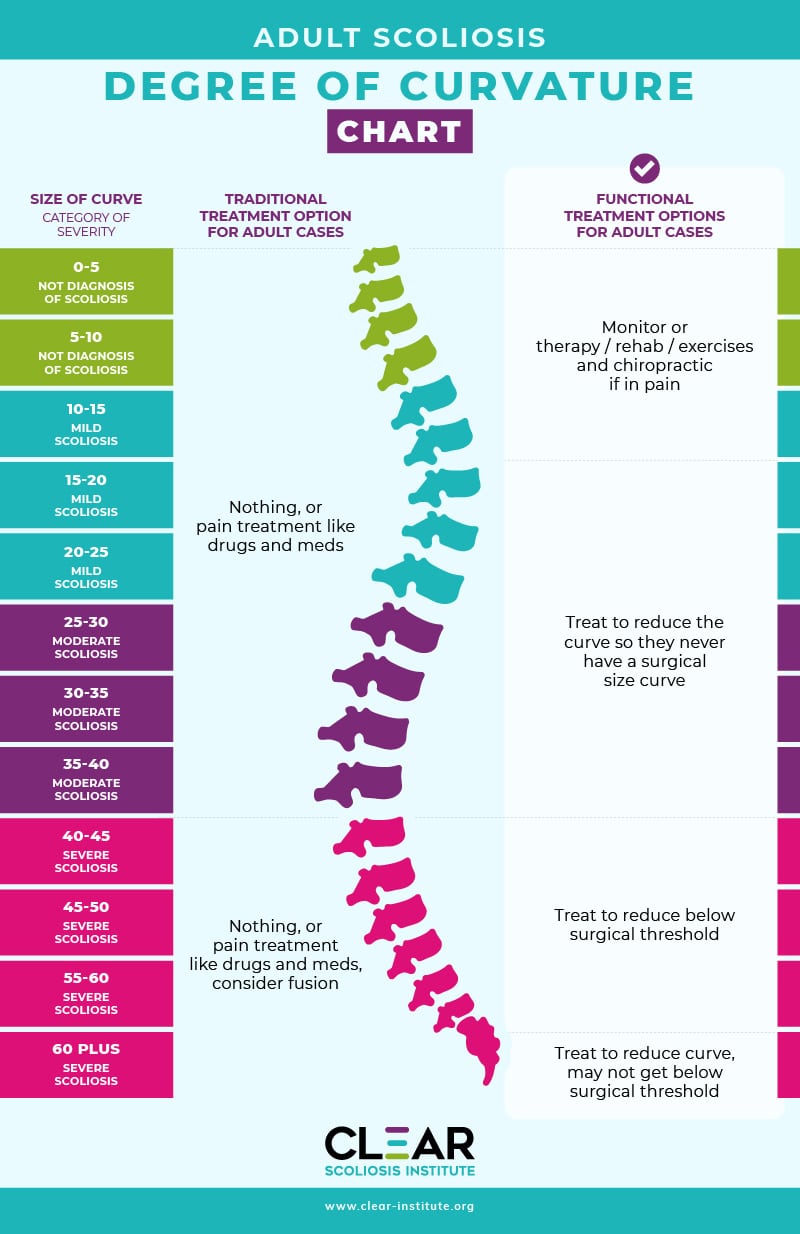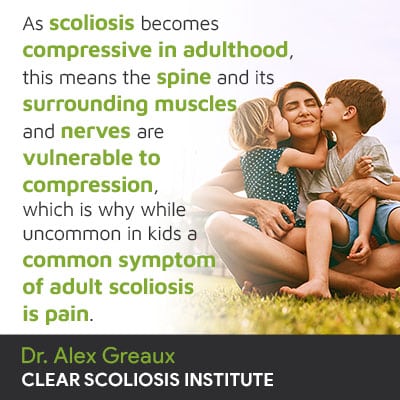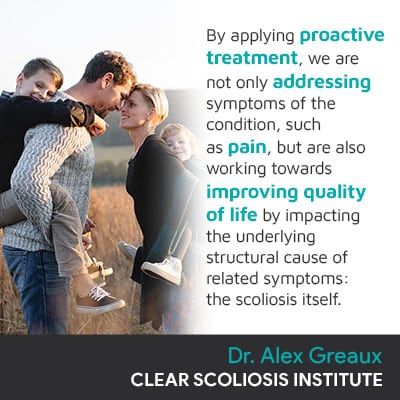![Adult Scoliosis Degrees of Curvature Chart [EXPLAINED] Image](https://clear-institute.org/wp-content/uploads/2022/08/adult-scoliosis-degrees-of-curvature-chart.jpg)
Scoliosis is a highly-variable condition, which is why the very nature of scoliosis necessitates a customized treatment approach. There are two main scoliosis treatment approaches for patients to choose between, each offering a different potential outcome; follow along on the accompanying scoliosis degrees chart for a visual of how the traditional and functional treatment approaches address the various severity levels.
Scoliosis is more common in adolescents, but also affects adults; as the condition becomes compressive in adulthood, (particularly when the curve is in the lower back), adults experience it differently. Regardless of age, proactive treatment is key, but different treatment approaches respond differently at each severity level.
Before we move onto the specifics of scoliosis treatment at the various levels of progression, let’s briefly introduce the condition with a focus on diagnosis and condition severity.
In order to reach a scoliosis diagnosis, certain parameters have to be met.
Scoliosis involves the development of an unnatural sideways spinal curve, with rotation, meaning it doesn’t just bend unnaturally to the side, but also twists from front to back, back to front, making it a 3-dimensional condition.
In addition, scoliosis is first diagnosed at 10+ degrees, and this is determined by a measurement known as Cobb angle; anything measuring less than 10° is not a scoliosis.
A patient’s Cobb angle is measured during X-ray and involves drawing lines from the tops and bottoms of the most-tilted vertebrae at the apex of the curve; the resulting angle is expressed in degrees and places conditions on a severity scale of mild to moderate and severe:

Although the condition’s most-prevalent type is adolescent idiopathic scoliosis (AIS), diagnosed between the ages of 10 and 18, adults experience it too; the two most common types to affect adults are idiopathic and degenerative.
Adults with idiopathic scoliosis are cases of AIS that remained undiagnosed and untreated during adolescence, and degenerative scoliosis is caused by natural age-related spinal degeneration.
Now, at any age, scoliosis is progressive, meaning it’s in its very nature to worsen over time, particularly if left untreated, or not treated proactively, so let’s move on to discussing how the chart shows the two main treatment approaches responding at each severity level.
The biggest trigger for progression is growth, and as adults don’t face that trigger, having reached skeletal maturity, progressive rates tend to slow down for adults; however, it’s important to understand that the cumulative effect of slow progression over time can still result in a significant curvature-degree increase.
A Cobb angle measurement of between 10 and 25 degrees is classified as mild scoliosis, and depending on the treatment approach a patient is committed to, the response can be no treatment, or proactive treatment applied as close to the time of diagnosis as possible.
Traditional treatment: for those on the path of traditional treatment, adult patients diagnosed with mild scoliosis don’t start active treatment.

In children and adolescents, the spine is still growing, so its constant lengthening motion counteracts the compressive force of the unnatural spinal curve, which is why scoliosis is not commonly painful until it becomes compressive in adulthood.
While traditional treatment is likely to address pain management at this stage with prescription pain medications and/or steroid injections, this is only addressing a symptom of the condition, and not the condition itself: an important distinction.
In fact, pain medication can actually be harmful by masking escalating symptoms related to progression, and by extension, the need for treatment.
Functional Treatment: under a functional treatment approach, a case of mild adult scoliosis would involve continuous monitoring for progression, but also the application of proactive treatment.
By integrating scoliosis-specific therapy, exercise, and chiropractic care, we address pain differently than in the traditional approach, and based on important patient/condition characteristics, we would decide whether corrective bracing should be introduced.
Monitoring of our adult patients doesn’t just involve watching for signs of further progression, but also observing how the spine is responding to treatment and adjusting treatment plans accordingly.
Also known as conservative and/or chiropractic-centered, functional treatment, at this level, has the goal of addressing the underlying structural nature of scoliosis by working towards a curvature reduction, which also addresses related symptoms, such as pain.
Moderate scoliosis involves a Cobb angle measurement of between 25 and 40 degrees, and in many cases, it’s when a condition progresses from mild to moderate that it starts to produce more-noticeable symptoms.
In addition to pain, adults also experience postural deviation such as a prominent lean to one side and the development of a rib arch that’s most noticeable when in a forward-bend position.
Traditional treatment: traditional treatment would continue to respond to the moderate severity level solely with pain medication/injections to provide pain management, which can be effective for short-term pain relief, but does little to address its underlying cause for sustainable and long-term pain management.
Functional Treatment: in the treatment of moderate adult scoliosis, we are actively working towards achieving a curvature reduction on a structural level.
While applying chiropractic care to impact the condition on a structural level, we would continue monitoring how the spine is responding to treatment and apportion the different treatment disciplines accordingly: chiropractic care, therapy, rehabilitation, and corrective bracing.

At a Cobb angle measurement of 40+ degrees, this is classified as severe scoliosis, and related symptoms such as postural deviation and pain can escalate at this level; in addition, if left untreated, severe scoliosis can involve related complications such as digestive issues and, less commonly, lung impairment.
Traditional treatment: under traditional treatment, even with a 40 - 60+ curvature-degree, treatment would continue to consist solely of medication to address pain.
It’s when an adult patient has progressed into the severe classification that they are approaching the surgical-level threshold and tend to be funneled towards spinal fusion surgery; this is because it’s clear that continued progression is occuring, and related symptoms and pain are likely to escalate alongside increasing condition severity.
While spinal fusion has its place in scoliosis treatment, like all surgical procedures, it comes with its share of risks and potential side effects; in addition, scoliosis surgery is lengthy, invasive, and costly.
Functional treatment: at the 40 - 60+ curvature-degree range, the goal is to stabilize the spine and reduce the curvature size to below the surgical threshold so the need for surgery, and its associated risks, can be avoided.
In many cases, a focus of treatment for adult scoliosis is to reduce the curvature to the size it was prior to causing noticeable symptoms like pain; if successful, we then work towards sustaining that reduction, increasing core strength so the spine is optimally supported and stabilized, and the hardships of increasing condition severity and the need for invasive surgery is avoided.
As a CLEAR-certified scoliosis chiropractor, my adult patients benefit from a functional treatment approach that strives to preserve as much of the spine’s natural function as possible.
While there are no treatment guarantees, by being proactive and applying treatment as close to the time of diagnosis as possible, I can help my adult patients work towards a curvature reduction on a structural level, which can also provide long-term and sustainable pain management by addressing its underlying cause: the condition itself.
As you can see from the accompanying scoliosis degrees chart, the traditional approach wastes valuable treatment time by focusing solely on monitoring and medicating, until conditions cross the surgical-level threshold and are funneled towards spinal fusion surgery.
As a progressive condition that can range from mild to moderate and severe, it’s important that each case of scoliosis is responded to with proactive treatment that’s customized to address key patient/condition variables.
It’s also important to remember that although adults have the big progressive trigger of growth removed, the cumulative effect of even incremental progression can add up to a significant curvature-size increase over time.
By being proactive with adult scoliosis, we can help patients manage progression and pain, while preserving as much spinal function as possible, by working towards reducing curves back to where they were prior to causing noticeable pain and related symptoms.
Regardless of age, the time for proactive treatment is always now, as improvements can be worked towards that improve quality of life throughout treatment and beyond.

CLEAR provides a unique and innovative way of understanding scoliosis. Sign up to receive facts and information you won’t find anywhere else.
